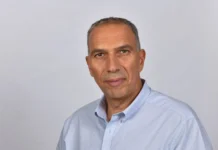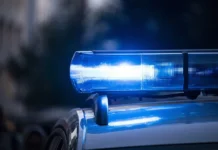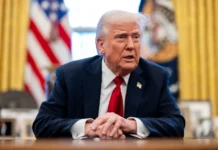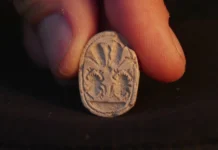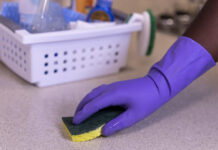The 3rd Jerusalem Biennale for Contemporary Jewish Art, which will showcase the work of nearly 200 professional artists, Israeli and international, in dozens of exhibitions and installations in eight venues around the city, will run from October 1 through November 16. The Jerusalem Biennale, which explores the places where contemporary art intersects with the Jewish world of content, will take the concept of Watershed as its theme.
Jerusalem Biennale Founder Rami Ozeri said in a statement: “The Jerusalem Biennale provides a stage for professional artists – from secular to ultra-Orthodox – who refer in their artwork to Jewish thought, spirit, tradition or experience. After two successful Biennales and invitations to exhibit contemporary Jewish art around the world, the Biennale will throw the spotlight onto the concept of watershed, examining it from a literal, metaphorical and even historical perspective. The theme finds its expression in issues as varied as Jewish identity, immigration and refugees, alongside watershed moments in history such as the Balfour Declaration and even the US presidential election.”

These exhibitions include:
Dreamland Never Found, in which artists who emigrated from the FSU as children, address migration from the perspective of a longing for childhood memories. Dreamland explores the artists’ desire to uncover their individual and collective roots and search for a past which ultimately is nowhere to be found. Curator: Maria Veitz.

Homelands explores artists’ reflections on one of the defining watershed moments from the last century: the disbanding of Jewish communities throughout the Muslim world, presenting this issue from both a personal and communal perspective. Curator: Dr. Meirav Balas.
585,000 m2 features Hungarian artists who reflect upon symbolic spaces found in the 7th district of Budapest’s Jewish Quarter, through visual art statements from the pre-World War II period to the present day. Curator: Andrea Ausztrics.
The Tower of David Museum will host two Jerusalem Biennale exhibitions:
Alternative Topography – Israeli architect-artist Avner Sher explores the tension between permanence and the ephemeral that is arguably inherent in Jerusalem’s spiritual and urban geography. Alternative Topography is comprised of two series, Maps of Jerusalem and Spolia, which address city space that is perpetually devolving. Sher will build a large scale temporary structure on the balcony of the Tower of David Museum, visible from the city. Curator: Dr. Smadar Shefi

The Space Within – Lili Almog transforms the women obscured under their black dresses into silhouettes creating a barrier within the urban landscape and instilling curiosity over the missing information. Curator Eilat Lieber
Other exhibitions include:
Mamzerim – an exhibition in which four Israeli artists explore the painful realities of Judaism’s “untouchable” caste, probing the very heart of the complex relations between state and religion in Israel. Curator Nurit Jacobs Yinon will launch a book on the subject at the Biennale.

Adam – Created as Male and Female showcases four well established Israeli artists: Micha Ullman, Efrat Natan, Hila Ben-Ari and Nechama Golan. Bringing together works from these artists who come from differing social and religious circles reveals a common ground- that of Jewish culture and its position of full equality between women and men. Curators: Rivka Baklash and Ruti Rubenstein
To and Fro is a group exhibition of French artists or artists residing in France who relate to the French interpretation of the texts of Rabbi Nahman of Bratslav. Curator: Dr. Batsheva Goldman-Ida
Water, Heart, Face – the exhibition, whose title comes from the verse in Proverbs “As in water face reflects face, so the heart of man to man” focuses on the entanglement between artist and observer when a work of art is presented. Curator: Avital Naor Wexler
The Biennale will also host an American Pavilion with three exhibitions hailing from the States:
Flashpoints – A Collective Response, a collaborative exhibition from the Jewish Arts Initiative of Southern California that highlights America’s fractured soul, exposed subsequent to the US presidential election.

Jerusalem Between Heaven and Earth – from the Jewish Art Salon in New York City addresses watershed issues related to Jerusalem and its topography.
Jerusalem Artists in the New World, in which three artists from Dallas Texas explore the watershed moment of Judaism’s arrival into the New World.
In honor of the Balfour Declaration centennial, Biennale2017 will showcase specially-commissioned works by three British artists exploring this watershed in recent Jewish history and host a special event in the Knesset (November).

Biennale2017 exhibition venues include the Tower of David Museum; the Bible Lands Museum; the Polonsky Building at the Van Leer Institute, the Austrian Hospice in the Old City, Beit Hasid on Emek Refaim, the Bezeq building on Chopin Street, the Skirball Museum at the Hebrew Union College and the Museum of Underground Prisoners in the Russian Compound.
Gallery talks and panel discussions with artists and curators will be available, as well as private and group tours guided in English and Hebrew. Tours in additional languages can be arranged on request and based on availability – tours@jerusalembiennale.org
Each venue will have its own opening event (detailed information to be published nearer the time).

